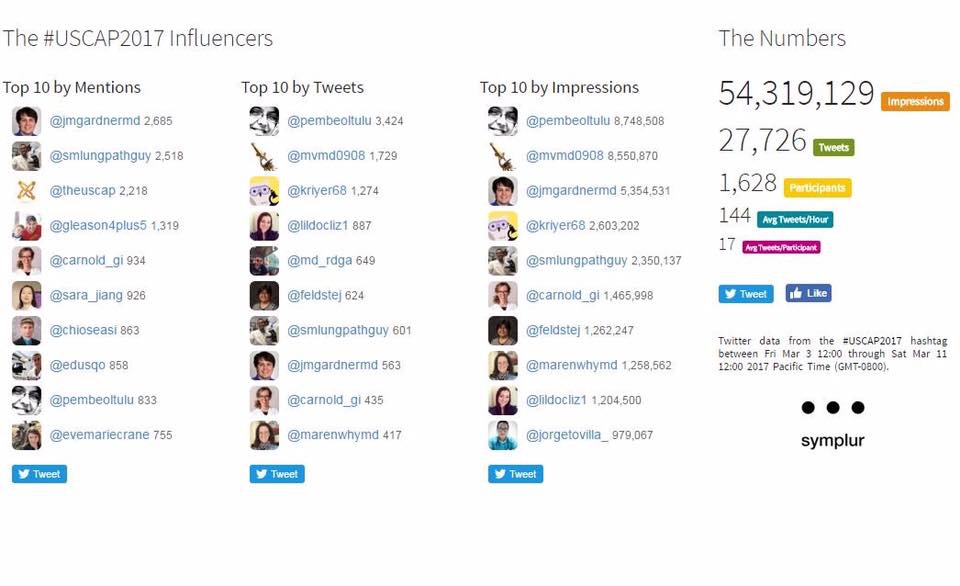“Academic” Tweeting – Is it “Academic” and Will it Be Recognized as Such?
 Dr. Bruce Friedman over at Lab Soft News has an interesting post today on “The “Why” and “How” of Academic Tweeting”. Many of you know that Bruce is widely considered the grandfather of pathology informatics, coining the term decades ago, envisioning organizations, societies, fellowships before many. He and Mike Becich are two people I would consider doing more for the field from their respective perches at the University of Michigan and University of Pittsburgh for the past several decades from their generation. Their efforts have spawned the next generation of pathology informaticians that are running their own pathology departments, divisions, companies and contributing the body of knowledge writing, speaking, researching , developing and directing fellowship programs. Both Bruce and Mike have run informatics meetings for decades and continue to do so. The upcoming Pathology Informatics Summit 2017 is the product of more than 40 cumulative years of experience in providing CME in pathology informatics going back to the first meetings in Ann Arbor in 1983.
Dr. Bruce Friedman over at Lab Soft News has an interesting post today on “The “Why” and “How” of Academic Tweeting”. Many of you know that Bruce is widely considered the grandfather of pathology informatics, coining the term decades ago, envisioning organizations, societies, fellowships before many. He and Mike Becich are two people I would consider doing more for the field from their respective perches at the University of Michigan and University of Pittsburgh for the past several decades from their generation. Their efforts have spawned the next generation of pathology informaticians that are running their own pathology departments, divisions, companies and contributing the body of knowledge writing, speaking, researching , developing and directing fellowship programs. Both Bruce and Mike have run informatics meetings for decades and continue to do so. The upcoming Pathology Informatics Summit 2017 is the product of more than 40 cumulative years of experience in providing CME in pathology informatics going back to the first meetings in Ann Arbor in 1983.
Many know the over 3,000 posts on this blog in nearly 10 years as of this July would never have seen a computer monitor or handheld device had Bruce not “dared” me to do so at a CAP Futurescape Conference in Chicago in the Summer of 2007. He and I along with another pathology blogger shared our thoughts several years ago on “Ten important lessons we have learned as a pathology bloggers” in the Journal of Pathology Informatics. There are probably 100 more I could add to this editorial as an update.
Bruce admittedly was the first and oldest, or most experienced pathologist to blog and continues to do so on a regular basis for more than a decade.
Points being he has spent some time thinking about informatics and the role of social media as a personal and professional endeavor.
His post and the peer reviewed references he cites do not entirely answer the question about how social media, in general, and “tweeting” in particular are being addressed in terms of “academic credit” for doing so.

Statistics and image courtesy of Dr. Jerad Gardner
Having been part of a group that published a paper on “#InSituPathologists: how the #USCAP2015 meeting went viral on Twitter and founded the social media movement for the United States and Canadian Academy of Pathology” and having been part of the groups that have continued to what has been referred to as “microblogging” using hashtags such as #USCAP2016 and #USCAP2017 and the like, I am not convinced the largely traditional, conventional “academic” community will recognize this as an “academic” pursuit.
Historically, peer-reviewed publications, such as those referenced by Bruce and myself, those that we or anyone else writes that are submitted in journals that are regarded as being credible sources of information have a peer-review process to check the scientific process, writing, results and conclusions. It is the bedrock of publishing in medicine and other industries. Of course, it has been discovered this process sometimes fail with numerous references, ironically sometimes on blogs, easily identifiable with minimal search terms. Here is an article from The New England Journal of Medicine that has a quote mentioning “this is officially becoming a trend”. 34 articles are referenced in the article with mention of inaccurate results, inappropriate authorship and much more.
But this is the process by which we are all to follow and if you are an author, reviewer and/or participate with industry-sponsored research all are suppose to follow to protect patients, researchers, institutions and companies.
The good and bad of social media, Twitter, Facebook, LinkedIn, blogs, Pinterest, Instagram, etc… is that the content is not peer-reviewed in the conventional methods. If I say the sushi I am eating is the best in the world on Instagram with a photo, one can agree or “like it”, comment, share, disagree, refute, ignore, etc… but anyway someone views/interprets that is only an opinion and not peer-reviewed and that is the point.
It is not intended to be.
Ditto if I make a claim on Facebook that the Cubs are going to win the World Series (again). My colleagues, friends, followers, watchers, editors, etc… won’t be able to “accept” or “accept with revisions” or “reject” before they see it on the feed. Effectively, social media allows anyone with a cell phone and Internet to be a photo journalist, story teller, microblogger, author, etc…Being respectful that professionals that publish newspapers, produce radio/television news and peer-reviewed Internet publications are and should be regarded differently. No way most of us out here in the blogosphere are ever going to compete with cable, print, radio, syndicated columnists, etc…
This goes back more than 5 years with thoughts on “No approval necessary“. No committees, boards, government agencies, regulatory bodies, etc…No spousal, team, company, policy, group, media or IRB approval needed.
All that being said, I think this is the advantage of “academic” tweeting, pertinent to Bruce’s comments, tweeting about new research publications, regulatory changes, keeping up to date, crowd sourcing, opening dialogue, etc…does benefit those who contribute and follow with millions of impressions and sharing and those of us who do it see the advantages.
I am just not sure it will be regarded as “academic” in the conventional sense for some time to come until the residents of today live tweeting and microblogging become the chairs and editors of tomorrow.
Comments (2)
Justin Prof GC FAURE after many years taking care of an educational website
http://www.assim.refer.org
I am now into content curation using scoop.it for research and teaching, in the immunology field and more
it allows also to use tweeter, linkedin, google+, facebook… but mainly is of major interest to retrieve information
at your disposal for any information, (PPTs available about endusers, PhD usage…)

































I’m a fairly new pathologist to the social media scene and a fairly new pathologist all together since I’m just about finished with fellowship. Pathology tweets seems to be a really big thing these days. What’s the alternative to tweeting if Twitter doesn’t survive?
I’m working on a free standing blog to share my perspective as a pathologist. Sometimes 140 characters isn’t quite long enough. If you know of anyone who is interested in contributing, check on my new site at http://www.pathspective.com
See you at the next annual meeting!